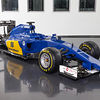Sauber reveals conservative C34

The Sauber F1 Team have revealed images of their new C34 car, a design that was made to flush away the disappointing 2014 season in which the team failed to score a single point.
Still powered by a Ferrari power unit, the C34 will be driven by a new driver pairing in Markus Ericsson, switching from Caterham, and Felipe Nasr, embarking on his first full racing season in Formula One.
The car steps away from Sauber's traditional grey livery, instead featuring an all blue livery and yellow sidepods to represent the team's major backer, Banco do Brasil.
After a season with the most comprehensive technical changes in the history of Formula One, there are significantly fewer regulation changes for the 2015 season. During the development of the new Sauber C34-Ferrari the Sauber F1 Team’s engineers focused on three areas: performance in slow corners, weight reduction, as well as braking stability.
Eric Gandelin, chief designer of the Sauber F1 Team, explained: “We were able to gain a lot of experience during the course of the 2014 season, which will have an influence on the Sauber C34.”
Aerodynamics traditionally play a key role in the development of a new car. But on this occasion it wasn’t only a question of optimising downforce and drag, but also improving the balance of the car and its responses in particular through low-speed corners.
The greatest visual difference compared to the Sauber C33 can be found around the nose section, which is now bigger in volume and lower to the ground following further changes to the technical regulations. This has a considerable impact on the aerodynamics of the entire car: the nose and front wing play a key role in determining how the air flows around the front wheels and how effectively the central and rear sections of the car function aerodynamically. The new design of the wheel rims has progressed in a similar direction, in the interests of optimising airflow around the front wheels.
The front suspension concept has changed little, with the springs and dampers again pushrod-actuated. However, the engineers put a lot of effort into improving the feedback from the steering for the drivers.
The sidepods of the new Sauber C34, are now slimmer than those of the Sauber C33, despite higher cooling requirements from the new power unit. This has been made possible by modifications to the attachment of the side crash elements. In addition, the architecture of the radiators, which are now positioned horizontally, has been fundamentally revised. The engineers also paid great attention to the flexibility of the cooling system, which can be adapted precisely – and individually for the various components – to the ambient temperature and circuit characteristics. For example, small air vents on the side of the cockpit are only used in certain situations.
Beyond this, the rear section as a whole is less voluminous, which benefits aerodynamic efficiency.
The car’s minimum weight has been increased in line with the FIA’s technical regulations, up from 691 kg a year ago to 702 kg now. The engineers, of course, set out to undercut this figure in order to give themselves ample room for manoeuvre when it comes to weight distribution – an important factor in determining how the car uses its tyres.







